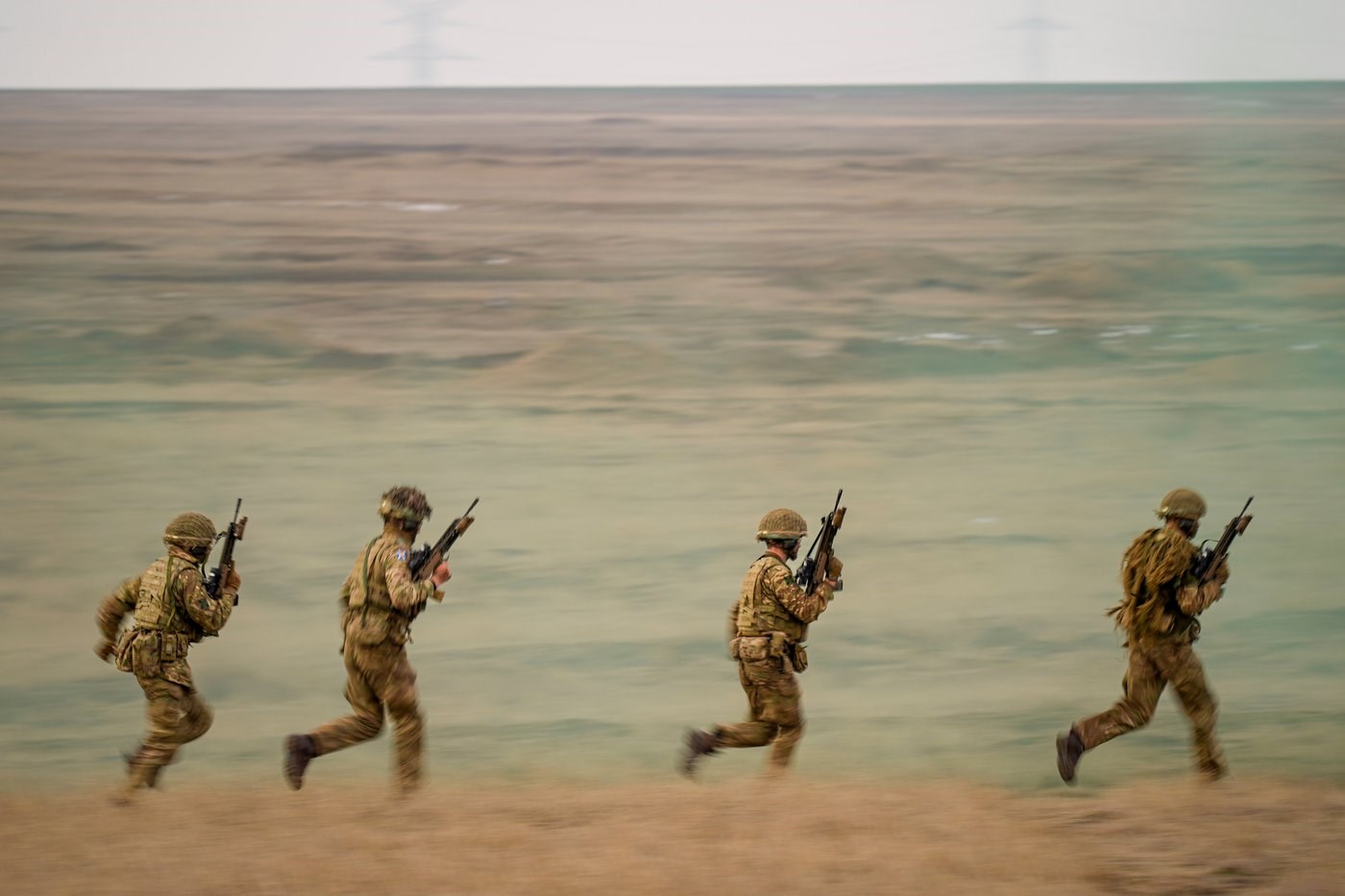
FILE- Servicemen run during the Steadfast Dart 2025 exercise, involving some 10,000 troops in three different countries from nine nations, representing the largest NATO operation planned this year, at a training range in Smardan, eastern Romania, Wednesday, Feb. 19, 2025. (AP Photo/Vadim Ghirda, file)
Republished October 29, 2025 - 11:27 AM
Original Publication Date October 29, 2025 - 5:41 AM
BRUSSELS (AP) — The U.S. confirmed on Wednesday that it will reduce its troop presence on NATO’s borders with Ukraine but shed no light on any future cuts, as its allies worry about a security gap being created at a time when Russia is increasingly confrontational.
The news first came from Romania, whose defense minister said the decision reflects Washington’s shift “toward the Indo-Pacific” region. However, Ionut Mosteanu said allied troop numbers would remain above the number before Russia’s full-scale invasion of neighboring Ukraine in 2022.
The U.S. armed forces later confirmed the move, but denied it was a sign of lessened commitment to NATO. Analysts say it might tempt Russia to test the military alliance.
Depending on operations and exercises, around 80,000-100,000 U.S. troops are usually present on European soil. NATO allies have expressed concern that the Trump administration might drastically cut their numbers and leave a security vacuum as European countries confront an increasingly aggressive Russia.
The administration has been reviewing its military “posture” in Europe and elsewhere, but U.S. officials have said that the findings of the review were not expected to be known before early next year.
NATO has recently been bulking up its defensive posture on its eastern flank bordering Belarus, Russia and Ukraine after a series of airspace violations by drones, balloons and Russian aircraft.
European build-up
The Romanian defense ministry said the U.S. decision will “stop the rotation in Europe of a brigade that had elements in several NATO countries,” including at a base in Romania.
It said in a statement that about 1,000 U.S. troops will remain stationed in Romania. As of April, more than 1,700 U.S. military personnel were estimated to be deployed there. A brigade usually numbers anywhere from 1,500 to 3,000 troops.
“Our strategic partnership is solid, predictable and reliable,” Mosteanu said in a news conference.
In a post on X, U.S. Ambassador to NATO Matthew Whitaker said the U.S. “remains committed to Romania.”
“Our strong presence in and enduring commitment to Europe remains steadfast, including support for Eastern Sentry,” a NATO operation along the eastern flank, he wrote. He did not mention the troop drawdown.
After the war started in 2022, NATO bolstered its presence on Europe’s eastern flank by sending additional multinational battle groups to Romania, Hungary, Bulgaria and Slovakia. Many more European troops are now stationed there.
The Romanian statement said the U.S. “decision also took into account the fact that NATO has strengthened its presence and activity on the Eastern Flank, which allows the United States to adjust its military posture in the region.”
101st Airborne troops to fly out
In a statement later on Wednesday, U.S. Army Europe and Africa said the 2nd Infantry Brigade Combat Team of the 101st Airborne Division will return to its base in Kentucky as previously planned but that no other U.S. troops would rotate into Europe to replace it.
“This is not an American withdrawal from Europe or a signal of lessened commitment to NATO and Article 5,” it said, in a reference to the collective security guarantee in the organization’s treaty that an attack on one ally should be considered an attack on all 32.
“Rather this is a positive sign of increased European capability and responsibility. Our NATO allies are meeting President Trump’s call to take primary responsibility for the conventional defense of Europe,” it said.
It insisted the move “will not change the security environment in Europe.”
However, top Republican lawmakers overseeing the military in Congress spoke out against the move, issuing a rare rebuke of an action taken by the leader of their own party.
In a joint statement, Sen. Roger Wicker and Rep. Mike Rogers, who chair committees overseeing the U.S. military, said it “sends the wrong signal to Russia at the very moment President Trump is applying pressure to force Vladimir Putin to come to the table to achieve a lasting peace in Ukraine.”
Government officials in Poland and Lithuania, which lie farther north along Europe’s eastern flank, said they had not been informed of any U.S. troop drawdown in their countries.
Giuseppe Spatafora, research analyst at the EU Institute for Security Studies, said that while the full extent of the American withdrawal is not yet known, "we do know the direction of travel: fewer US troops and assets, and an expectation that Europeans will fill the gap.”
Asked about the move, a NATO official said that “adjustments to U.S. force posture are not unusual.” Under the terms of their employment contract, the official is permitted to speak to reporters but only on condition that they not be named.
The official said that even with this new adjustment, about which NATO was informed in advance, the American “force posture in Europe remains larger than it has been for many years, with many more U.S. forces on the continent than before 2022.”
The official played down any security concerns, saying that “NATO and U.S. authorities are in close contact about our overall posture – to ensure NATO retains our robust capacity to deter and defend.”
Spatafora said the U.S. drawdown could undermine NATO's deterrent effect.
“Russia could be tempted to test NATO even further, without seeking to open a new front, but checking how the alliance responds” in future to more drone incidents or acts of sabotage, he told The Associated Press.
___
McGrath reported from Leamington Spa, England. Claudia Ciobanu in Warsaw, Geir Moulson in Berlin and Stephen Groves in Washington contributed to this report.
News from © The Associated Press, 2025